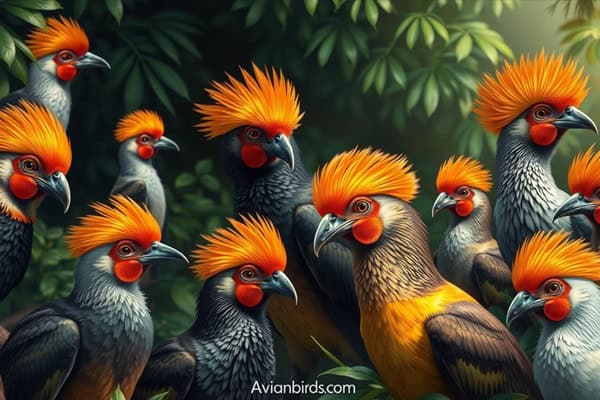8 Types of Hawks That Live in Florida! (With Pictures)
Do you know how many different hawk species live in Florida? Get ready to be amazed as we explore the world of hawks of Florida! From the majestic Red-shouldered Hawk to the elusive Swainson’s Hawk, Florida is home to many of these amazing birds of prey. Let’s go on an exciting journey to learn about the unique traits, habitats, and conservation status of the 9 hawk types in Florida. Get ready to learn more and see how important these raptors are to Florida’s ecosystem.
Hawks of Florida
Florida is a haven for hawks, each playing a key role in the state’s ecosystem. These birds of prey keep small mammals, reptiles, and birds in check. They help prevent any one species from taking over their homes. Hawks show us how healthy the environment is, needing large, untouched areas to live and breed.
Importance of Hawks in Florida’s Ecosystem
Hawks are vital in Florida for several reasons. They manage the number of small animals that could become pests. Hawks also show us the environment’s quality. They need big, untouched areas to survive and breed well.
Overview of Common Hawk Species in the State
Florida boasts a variety of hawk species, each with its traits and ways of adapting. Common hawks include the red-shouldered hawk, Cooper’s hawk, northern harrier, and red-tailed hawk. These birds can be seen flying over forests, grasslands, and coasts. They hunt for food and keep the ecosystem in balance.
| Hawk Species | Distinguishing Features | Habitat Preferences |
|---|---|---|
| Red-Shouldered Hawk | Reddish-brown shoulders, dark-and-light banded tail | Deciduous and mixed forests, urban areas |
| Cooper’s Hawk | Short, rounded wings, long, rounded tail | Deciduous and mixed forests, urban areas |
| Northern Harrier | Distinctive white rump patch, owl-like facial disc | Grasslands, marshes, open fields |
| Red-Tailed Hawk | Broad, rounded wings, reddish-brown tail | Adaptable to various habitats, including urban areas |
1. Red-shouldered Hawk
- Scientific name: Buteo lineatus
- Life span: 19 years
- Size: (43-61 cm)
- Weight: (486-774 g)
- Wingspan: (94-111 cm)
The red-shouldered hawk is a true gem of Florida’s diverse avian population. Also, These medium-sized raptors are known for their striking appearance. They have reddish-orange shoulders, barred chests, and black and white tails. As the most over hawk species in the state, they play a crucial role in Florida’s ecosystems.
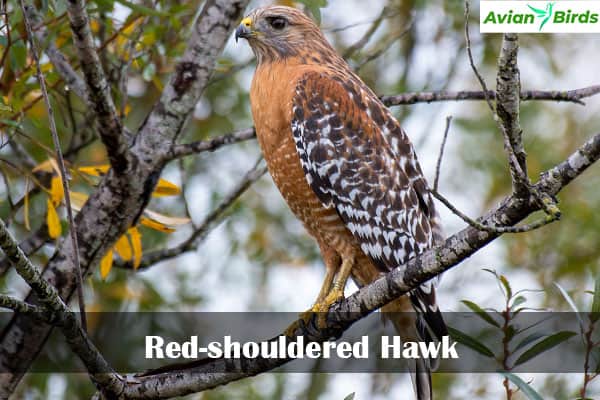
Identification and Characteristics
Identifying a red-shouldered hawk is easy thanks to their unique look. They have a stocky build with broad wings and a short, rounded tail. Their plumage is a rich mix of reddish-brown and white. The red shoulders and barred chest make them stand out from other hawks.
Habitat and Feeding Habits
Red-shouldered hawks live in moist, wooded areas. This includes bottomland hardwood forests, swamps, and even suburban neighborhoods. Also, They hunt small mammals, amphibians, reptiles, and small birds. They often perch on branches or glide low through the trees, using their sharp eyesight to catch their prey.
Breeding and Conservation Status
Despite adapting to human development, the red-shouldered hawk faces threats like habitat loss. They breed in late winter or early spring, building large nests high in trees. Thanks to conservation efforts, their status in Florida remains stable.
2. Cooper’s Hawk
- Scientific name: Accipiter cooperii
- Life span: 12 years
- Size: (37-39 cm)
- Weight: (220-410 g)
- Wingspan: (62-90 cm)
The Cooper’s Hawk is a medium-sized raptor found in Florida’s woods and suburbs. It’s known for its blue-gray back, rusty chest, and long tail. This bird is famous for its flying skills, chasing smaller birds at high speeds.
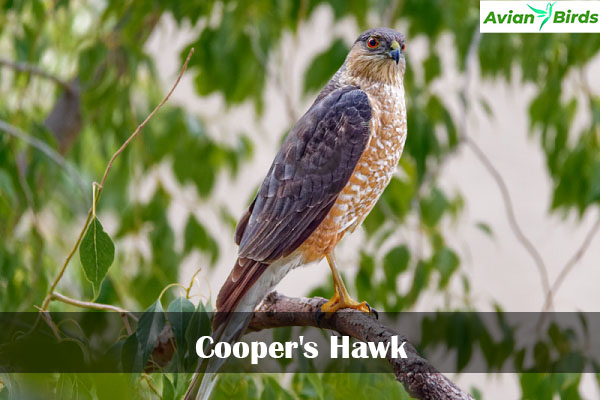
Cooper’s Hawks are common in Florida, especially in neighborhoods with backyard feeders. There were fewer in the mid-20th century due to pesticides. But thanks to conservation, they now live in Florida all year.
Hunting and Feeding Habits
Cooper’s Hawks are great hunters. They catch birds, small mammals, and reptiles with their sharp talons and beaks. They chase their prey from trees or bushes, catching it in mid-air.
Nesting and Breeding
They build their nests high in tall trees, often using last year’s nest. The female lays 3-5 eggs, and both parents incubate them for 30-36 days. The young stay with their parents for months, learning to hunt and fly.
Conservation Status
Cooper’s Hawks were fewer in the mid-20th century but have recovered. The ban on some pesticides and conservation helped. Now, they’re considered “Least Concern” by the IUCN, making them common in Florida’s ecosystems.
3. Northern Harrier
- Scientific name: Circus hudsonius
- Life span: 12 years
- Size: (46-50 cm)
- Weight: (300-750 g)
- Wingspan: (102-118 cm)
The northern harrier, also known as the marsh hawk, is a fascinating bird in Florida’s diverse landscapes. It stands out with its unique looks, hunting style, and love for open spaces. Birdwatchers and nature lovers find it quite intriguing.
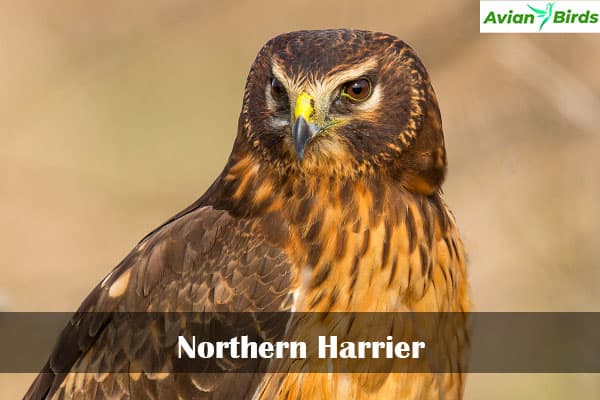
Distinctive Features
This bird is easy to spot with its owl-like face and a white patch on its rump. It has a slender body, long tail, and short, rounded wings. These features help it move swiftly and hunt low over the ground.
Habitat Preferences
Northern harriers love open areas like marshes, grasslands, and fields. They hunt small mammals, birds, reptiles, and amphibians there. In Florida, they visit during the winter, leaving in spring. They are most common in mid-winter.
Hunting Behavior
Their hunting is quite impressive. They use their sharp senses to find prey, flying low and slow. When they spot something, they dive fast to catch it with their sharp talons.
If you enjoy birdwatching or nature, don’t miss seeing the northern harrier in Florida. Watch them fly over marshes and fields. It’s exciting to see their hunting skills up close.
4. Red-Tailed Hawk
- Scientific name: Buteo jamaicensis
- Life span: 10-15 years
- Size: (50-65 cm)
- Weight: (900-1460 g)
- Wingspan: (114-133 cm)
The red-tailed hawk is a well-known bird of prey in Florida. It’s big, with broad wings and a reddish-brown tail. You can see it in many places, from forests to cities.

Physical Description
The red-tailed hawk is Florida’s biggest hawk, with a wingspan of up to four feet wide. It has a strong beak and sharp claws for catching small to medium mammals, birds, and reptiles. Its reddish-brown tail is its most recognizable feature.
Adaptability to Different Environments
Red-tailed hawks are great at living in many places in Florida. They do well in both natural and human-made environments. They often sit high to look for food. Red-tailed hawks even live in cities, flying over buildings to find food.
Red-tailed hawks are big, look unique, and can live in many places. They are a favorite among bird lovers and those who enjoy seeing them in everyday life. The red-tailed hawk is a symbol of Florida’s bird life.
5. Short-Tailed Hawk
- Scientific name: Buteo brachyurus
- Life span: 20 years
- Size: (38–43)
- Weight: (362 –500 g)
- Wingspan: (83-103 cm)
Florida is a haven for hawk species, each with its traits and habits. The short-tailed hawk is one such raptor that catches the eye. It’s a small bird of prey that thrives in the subtropical areas of the Sunshine State.

This hawk comes in two color forms: dark above and pale below, or almost all black. They are known for their skill in soaring and gliding through the sky. They look for small birds, reptiles, and large insects to eat.
Even though they are not common in the U.S., the short-tailed hawk is doing well in Florida. They live in big stick nests high up in trees. These nests are often found in forests and open areas, making them part of Florida’s lush landscapes.
Seeing a short-tailed hawk in the wild is a treat for bird lovers and nature fans. Their beautiful flight and striking looks show the amazing variety of birds in Florida.
| Characteristic | Description |
|---|---|
| Size | Small raptor, with a wingspan of around 36-40 inches |
| Coloration | Two distinct color morphs: dark above and pale below, or mostly black |
| Habitat | Subtropical habitats, particularly forested and semi-open areas in southern Florida |
| Prey | Small birds, reptiles, and large insects |
| Nesting | Builds bulky stick nests high in trees |
| Conservation Status | Stable population in Florida, though limited range within the United States |
6. Sharp-Shinned Hawk
- Scientific name: Accipiter striatus
- Life span: 5 years
- Size: (24-34 cm)
- Weight: (87-218 g)
- Wingspan: (43-56 cm)
The sharp-shinned hawk is the smallest in Florida, known for its amazing speed and agility. It’s easy to spot because of its blue-gray back, rusty underparts, and short tail. These features make it stand out.

Identification Tips
Look for a small size, round head, and a long, thin tail that’s slightly notched when you see a sharp-shinned hawk in Florida. They have a unique “bullet-shaped” look when they fly. Their wings are short and rounded, and they fly with a steady flap.
Seasonal Patterns and Migration
- Sharp-shinned hawks live in Florida all year, but more come in the fall and winter.
- They move south from their northern homes in the U.S. and Canada during these seasons.
- These hawks love to eat small songbirds. They often catch them from a hidden spot or chase them down in the trees.
The sharp-shinned hawk is a cool and hard-to-find bird in Florida. By knowing how to spot its special features and when to look, bird lovers can see these amazing birds all year.
7. Broad-Winged Hawk
- Scientific name: Buteo platypterus
- Life span: 12 years
- Size: (34-44 cm)
- Weight: (265-560 g)
- Wingspan: (81-100 cm)
In Florida, the broad-winged hawk is a standout among hawks. It’s known for its unique look and amazing migration patterns. This hawk has short, broad wings and a banded tail. It lives in the state’s forests but can be hard to spot because it likes dense woods.
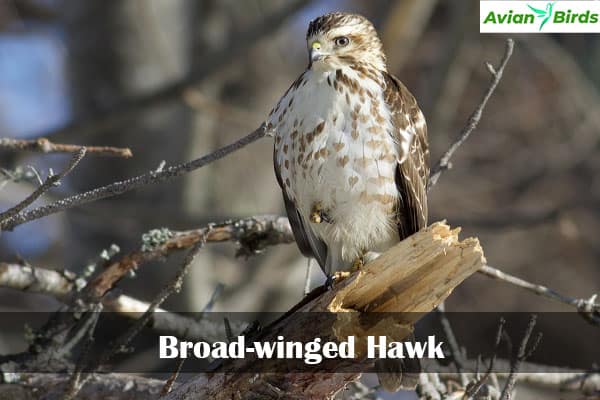
Distinguishing Characteristics
The broad-winged hawk is easy to spot because of its size and color. Adults have dark brown tops and a light underside. They also have a dark band on their tail tip. Young hawks look different, with a lighter belly and tail without the adult’s bands.
Migratory Behavior
The broad-winged hawk makes a big move every year. They spend summer in the U.S. and Canada, where they hunt for food. When winter comes, they fly all the way to Central and South America to escape the cold.
In Florida, bird lovers can see thousands of broad-winged hawks flying together in the fall. This is called a “kettle.” It shows how well these birds can navigate and how strong they are.
The broad-winged hawk’s migration is a wonder of nature. It shows how these birds adapt and survive over long distances. Their journey is key to their survival and the future of their species.
Read Our Previous Articles:
8. Swainson’s Hawk
- Scientific name: Buteo swainsoni
- Life span: 16-19 years
- Size: (48-56 cm)
- Weight: (693-1367 g)
- Wingspan: (117-137 cm)
The Swainson’s hawk is a rare bird in Florida, seen only a few times each year. It lives mainly in the western U.S. and Canada during the summer. Then, it travels to Argentina for the winter.

Even though they’re not often seen in Florida, their visits show how diverse Florida’s birds are. They highlight the need to keep Florida’s nature safe for all wildlife.
Swainson’s hawks stand out with their dark tops and light bottoms. They can be seen flying over open lands, looking for small animals, bugs, and reptiles to eat.
| Characteristic | Description |
|---|---|
| Wingspan | 45-53 inches |
| Length | 18-22 inches |
| Weight | 1.5-3.3 pounds |
| Habitat | Open areas, grasslands, agricultural fields |
| Diet | Small mammals, insects, reptiles |
The Swainson’s hawk’s rare visits to Florida remind us of the amazing variety of birds here. They also show why it’s crucial to protect the places where these birds live.
Hawks of Florida
Florida’s varied landscapes, from coastal marshes to urban parks, are perfect for birdwatchers. They offer great chances to see different hawk species. Knowing where and how to spot these birds can make you appreciate their role in Florida’s ecosystems more.
Best Places to Spot Hawks in Florida
Some top spots to see hawks in Florida are:
- Everglades National Park
- Merritt Island National Wildlife Refuge
- Various state parks and preserves throughout the state
These places have many habitats that attract hawks. They give birdwatchers great chances to see these birds in their natural settings.
Tips for Identifying Different Species
To identify hawks in Florida, look at their size, wing shape, tail patterns, and colors. Also, watch how they hunt and listen to their sounds. Learning these traits helps you know where to see hawks in Florida and how to identify hawks in Florida.
| Hawk Species | Key Identification Features |
|---|---|
| Red-Shouldered Hawk | Distinct reddish-brown shoulders, barred tail, and high-pitched “kee-yer” call |
| Cooper’s Hawk | Medium-sized with a rounded head, short, broad wings, and a long, rounded tail |
| Northern Harrier | Distinctive owl-like face, long tail, and low, gliding flight over open areas |
By exploring Florida’s diverse habitats and learning about each hawk’s traits, you can improve your birdwatching. You’ll also gain a deeper appreciation for these amazing birds of prey.
Wrapping Up…
Florida’s hawks show how important it is to protect our natural world. From the common Red-Shouldered Hawk to the rare Swainson’s Hawk, each hawk is key to Florida’s balance. By learning about these birds, we can help keep them around for the future.
This article has given you a deep look at Florida’s 9 main hawk species. It’s great for anyone who loves birds or nature. You’ll now know more about the Hawks of Florida and how to help them.
When you go to see these amazing birds, always be respectful of their home. Support groups that protect them and share your love for these birds with others. With our help, Florida’s hawks will continue to soar in the sky for a long time.






